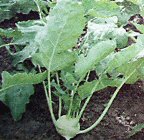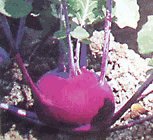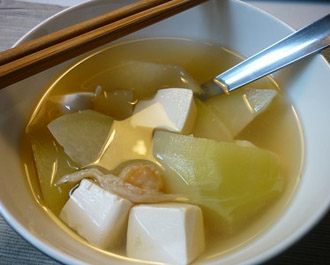Kohlrabi Nutrition facts
Kohlrabi, also known as knol-khol or German Turnip, is a stout, round, tuberous vegetable in the Brassica family, the large family which also includes cabbage, broccoli, cauliflower, kale, collard greens, and brussels sprouts. This stem vegetable is native to Europe. Scientific name: Brassica oleracea (Gongylodes Group).
Kholrabi is a perennial, cool-season vegetable. It is grown all over temperate climates for its succulent round-shaped modified stem as well for its turnip-flavored top greens.
 |
 |
| Kohlrabi-White variety. | Purple skin knol-khol. |
<
The crop requires well-drained fertile soil and average sunlight to flourish. Its edible stem attains maturity and is ready for harvest in 55-60 days after sowing. The approximate weight is 150 g. Unlike turnip, which is a root vegetable, kohlrabi, being a stem vegetable, is less prone to cracking and has a good standing ability for up to 30 days even after maturity.
Kohlrabis have similar taste and texture like that of a broccoli stem or cabbage, but milder and sweeter. Young, tender ones are crispier in texture, have a pleasant taste, and are rich in flavor.
Two main varieties of kohlrabi exist, white and purple. However, internally, both the "white" (actually light green) as well as purple types have similar cream-yellow color edible flesh. Some of the popular cultivars grown worldwide are white Vienna, white Danube, purple vienna, and grand duke.
Health benefits of Kohlrabi (Knol-khol)
Gently sweet, crispy textured kohlrabi is notably rich in vitamins and dietary fiber; however, it has only 27 calories per 100 g, a negligible amount of fat, and zero cholesterol.
Fresh kohlrabi stem is a rich source of vitamin-C; provides 62 mg per 100 g weight which is about 102% of RDA. Vitamin C (ascorbic acid) is a water-soluble vitamin and a powerful antioxidant. It helps the human body maintain healthy connective tissue, teeth, and gum. Its antioxidant property helps the human body combat diseases and cancers by scavenging harmful free radicals from the body.
Kohlrabi, like other members of the Brassica family, contains health-promoting phytochemicals such as isothiocyanates, sulforaphane, and indole-3-carbinol that are supposed to protect against prostate and colon cancers.
It especially contains good amounts of many B-complex groups of vitamins such as niacin, vitamin B-6 (pyridoxine), thiamin, pantothenic acid, etc., that act as co-factors to enzymes during various metabolism functions inside the body.
Knol-knol notably has good levels of minerals; copper, calcium, potassium, manganese, iron, and phosphorus are especially concentrated in it. Potassium is an important component of cells and body fluids that helps to regulate heart rate and blood pressure by countering the effects of sodium. The human body uses manganese as a co-factor for the antioxidant enzyme, superoxide dismutase.
Further, its creamy color flesh contains small amounts of vitamin-A and carotene pigments.
Kohlrabi leaves or tops, like turnip greens, are also very nutritious greens abundant in carotenes, vitamin A, vitamin K, minerals, and the B-complex group of vitamins.
| Principle | Nutrient Value | Percent of RDA |
|---|---|---|
| Energy | 27 Kcal | 1.5% |
| Carbohydrates | 6.20 g | 5% |
| Protein | 1.70 g | 3% |
| Total Fat | 0.10 g | <1% |
| Cholesterol | 0 mg | 0% |
| Dietary Fiber | 3.6 g | 10% |
| Vitamins | ||
| Folates | 16 µg | 4% |
| Niacin | 0.400 mg | 2.5% |
| Pantothenic acid | 0.165 mg | 3% |
| Pyridoxine | 0.150 mg | 11.5% |
| Riboflavin | 0.020 mg | 1.5% |
| Thiamin | 0.050 mg | 4% |
| Vitamin A | 36 IU | 1% |
| Vitamin C | 62 mg | 102% |
| Vitamin K | 0.1 µg | <1% |
| Electrolytes | ||
| Sodium | 20 mg | 1% |
| Potassium | 350 mg | 7% |
| Minerals | ||
| Calcium | 24 mg | 2.5% |
| Copper | 0.129 mg | 14% |
| Iron | 0.40 mg | 5% |
| Magnesium | 19 mg | 5% |
| Manganese | 0.139 mg | 6% |
| Phosphorus | 46 mg | 6.5% |
| Selenium | 0.7 µg | 1% |
| Zinc | 0.03 mg | <1% |
| Phyto-nutrients | ||
| Carotene-ß | 22 µg | -- |
| Crypto-xanthin-ß | 0 µg | -- |
| Lutein-zeaxanthin | 0 µg | -- |
Selection and storage
This visibly attractive stem vegetable is available during the winter months from November until March. Overmaturity, as well as exposure of the crop to excessive sunlight, makes its stem woody and tough resulting in its poor eating quality. Fresh kohlrabies should have a crunchy texture and impart a rich flavor.
In the stores, buy medium-sized, fresh tubers that feel heavy in hand for their size. Avoid those with cracks, cuts, spoiled, or mold-infested. Do not buy if they are lightweight for their size and excessively woody in texture as it indicates signs of overmaturity and therefore, unappetizing.
Knol-kohl exhibits good keeping qualities and can be placed at room temperature for 3-5 days. However, If you wish to store them for a few more days, then keep them in the refrigerator set at a temperature below 35 degrees F and a high humidity level to maintain vitality.
Preparation and serving methods
Kohlrabi should be washed thoroughly in clean running water and swished in saline water for about 10-15 minutes to remove any surface soil, dirt, and any insecticide/fungicide residues.
Just before cooking, remove any leaves and trim the stem ends. Peel the skin using a paring knife.
Here are some serving tips:
 |
| Kohlrabi, soybean curd (tofu) soup. Courtesy: Singzy |
Fresh young crispy knol-knol can be used raw in salad/coleslaw.
It mixes well with other vegetables and greens in a variety of kohlrabi recipes like squash empanadas.
Peeled stem, cut into slices or cubes, can be mixed with other vegetables like potatoes and stewed with onion, garlic, and tomato.
Stewed knol-knol cubes mix well with meats and poultry.
Safety profile
Kohlrabi may contain goitrogens, plant-based compounds found in the cruciferous vegetable like cauliflower, broccoli, etc., may cause swelling of the thyroid gland and should be avoided in individuals with thyroid dysfunction. However, a healthy person can eat them liberally. (Disclaimer).
≻≻-Back to Vegetables from Kohlrabi. Visit here for an impressive list of vegetables with complete illustrations of their nutrition facts and health benefits.
≻≻-Back to Home page.
Further resources:
Refer Stanford School of Medicine Cancer information Page- Nutrition to Reduce Cancer Risk.